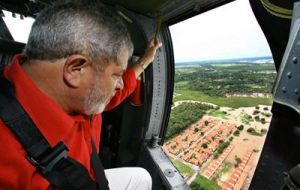MercoPress. South Atlantic News Agency
Brazil flooded in the north and under severe drought in the south
 President Luiz Inacio Lula da Silva visited the worst affected areas
President Luiz Inacio Lula da Silva visited the worst affected areas Brazil rushed aid Wednesday by air, over land and through rapidly rising waters to scores of cities and towns isolated by floods that have killed at least 32 and left nearly 200,000 homeless. However in the south the country is suffering a severe months-long drought which is threatening hydroelectricity generation and agriculture.
But rain continued to fall across a vast region stretching from the Amazon jungle to the north-eastern Atlantic coast and meteorologists predicted the bad weather could last for weeks. Some areas were experiencing their heaviest rainfall in two decades.
In three Amazon states, at least 3.000 Indians near rivers that overflowed fled to higher ground or into the jungle after seeing their crops of manioc, bananas and potatoes destroyed, said Sebastiao Haji Manchiner, executive secretary of the Brazilian Amazon Indigenous Organization.
In the hardest-hit state of Maranhao, some rivers were rising as much as 30 centimetres per day, destroying bridges and making it too dangerous for relief workers to navigate waterways.
The unusually heavy rains that have slammed the region for two months are now affecting 10 of Brazil's 26 states in a zone three times the size of Alaska. It stretches from the normally wet jungle to coastal states known for lengthy droughts, though not all parts of the states have been affected.
Most victims drowned or were killed when mudslides swept apart ramshackle homes, but authorities feared the situation could get much worse because some areas have been isolated for days without shipments of food or water.
Civil defence workers used army helicopters to airlift supplies to some places. Trucks laden with emergency shipments of food and water were forced to stop at highway washouts so aid workers could transfer the goods onto boats for delivery, said Abner Ferreira, a spokesman for Maranhao's civil defense department.
In the Para state city of Altamira, more rain fell in three hours than the jungle city of 90.000 normally gets in two months, Mayor Odileida Sampaio told the state-run Agencia Brasil news agency. About 5.000 buildings were damaged, and nearly a third of the city's residents were forced from their homes — many of whom live in rickety shacks erected atop stilts.
Floods created a crater and a lake along the path of a key iron ore export railway that takes raw ingredient for steel from a jungle mine to an Atlantic port. Railway owner, Companhia Vale does Rio Doce SA, said in a statement it was working on repairs and would reopen the railway as soon as possible.
Meteorologists blamed the rains on an Atlantic weather system that typically moves on by April but has remained longer this year.
The system “is staying farther south from where it usually stays this time of the year,” said Luiz Kondraski of Brazil's National Institute for Space Research. “If it were more to the north right now, the rains wouldn't be so intense”.
Meanwhile in the south of Brazil the lack of rain in the Parana-Uruguay basin is also affecting northern Argentina, Paraguay and Uruguay. The three countries have granted aid to drought-stricken farmers in the region and hydro electricity generation has plunged.
The shared Argentine/Uruguay dam of Salto Grande has a normal flow of 4.000 cubic metres per second, but now is down to less than 400 cubic metres per second. In exceptional periods the flow has ballooned to 21.000 cubic metres per second.




Top Comments
Disclaimer & comment rulesCommenting for this story is now closed.
If you have a Facebook account, become a fan and comment on our Facebook Page!